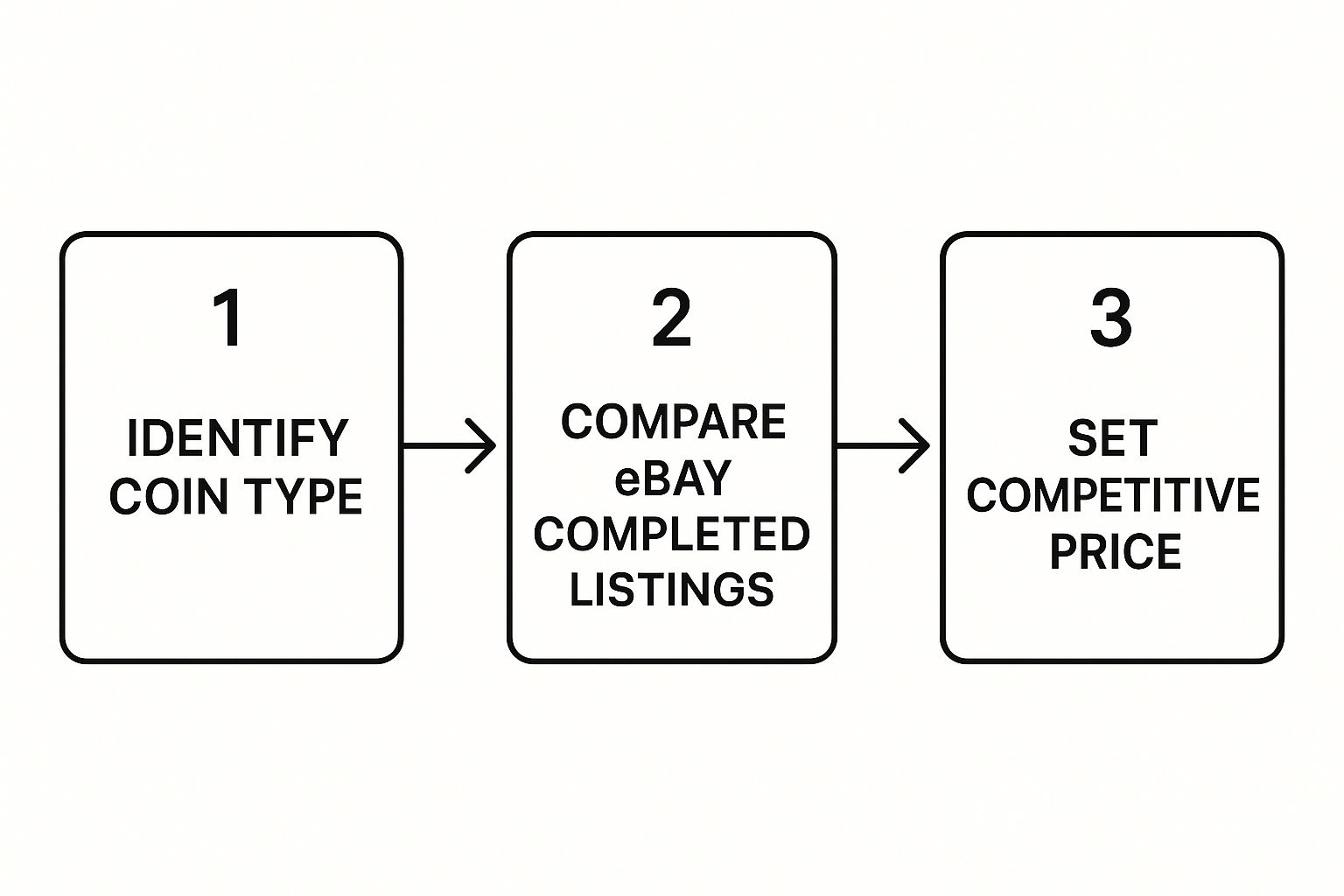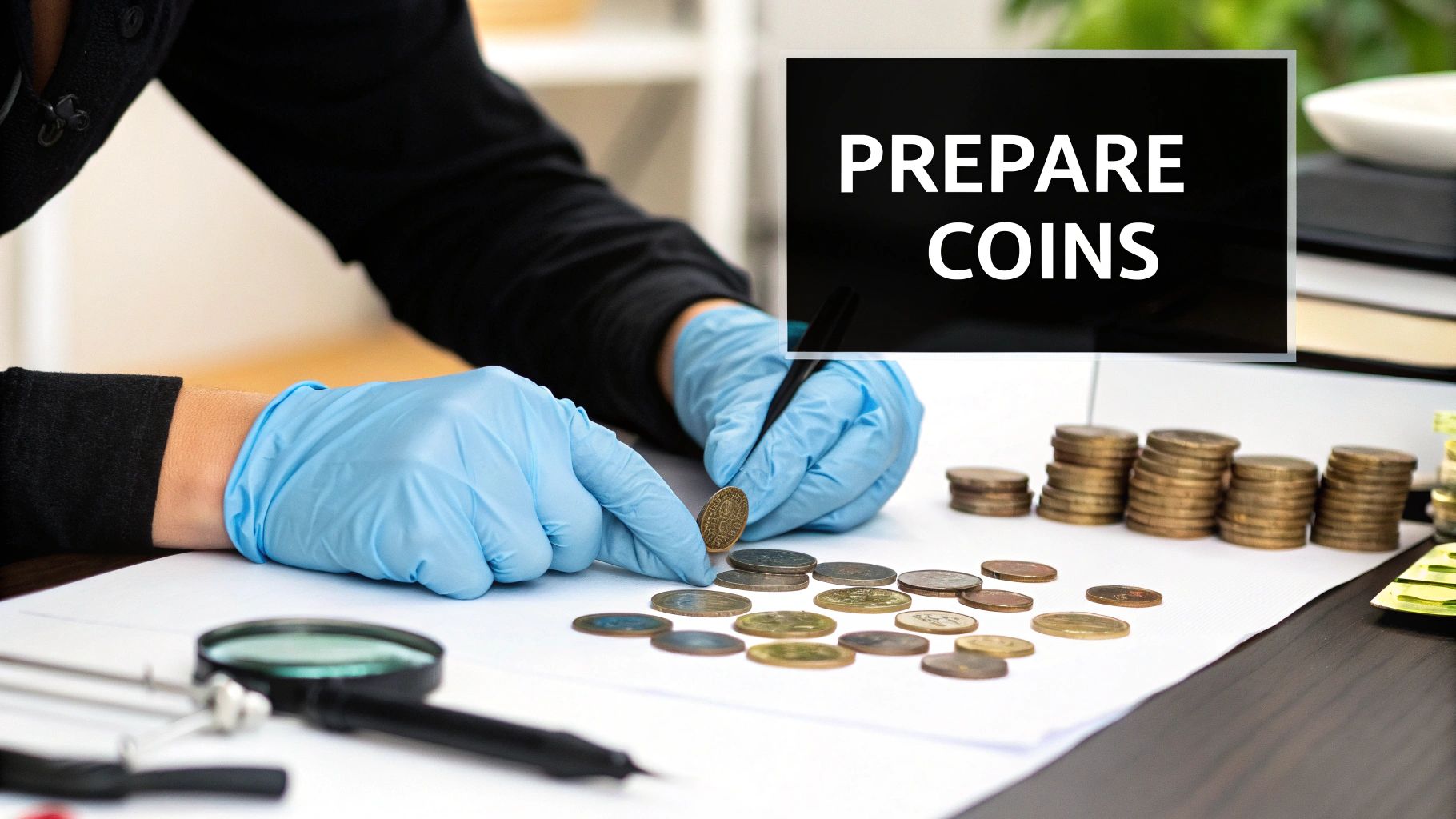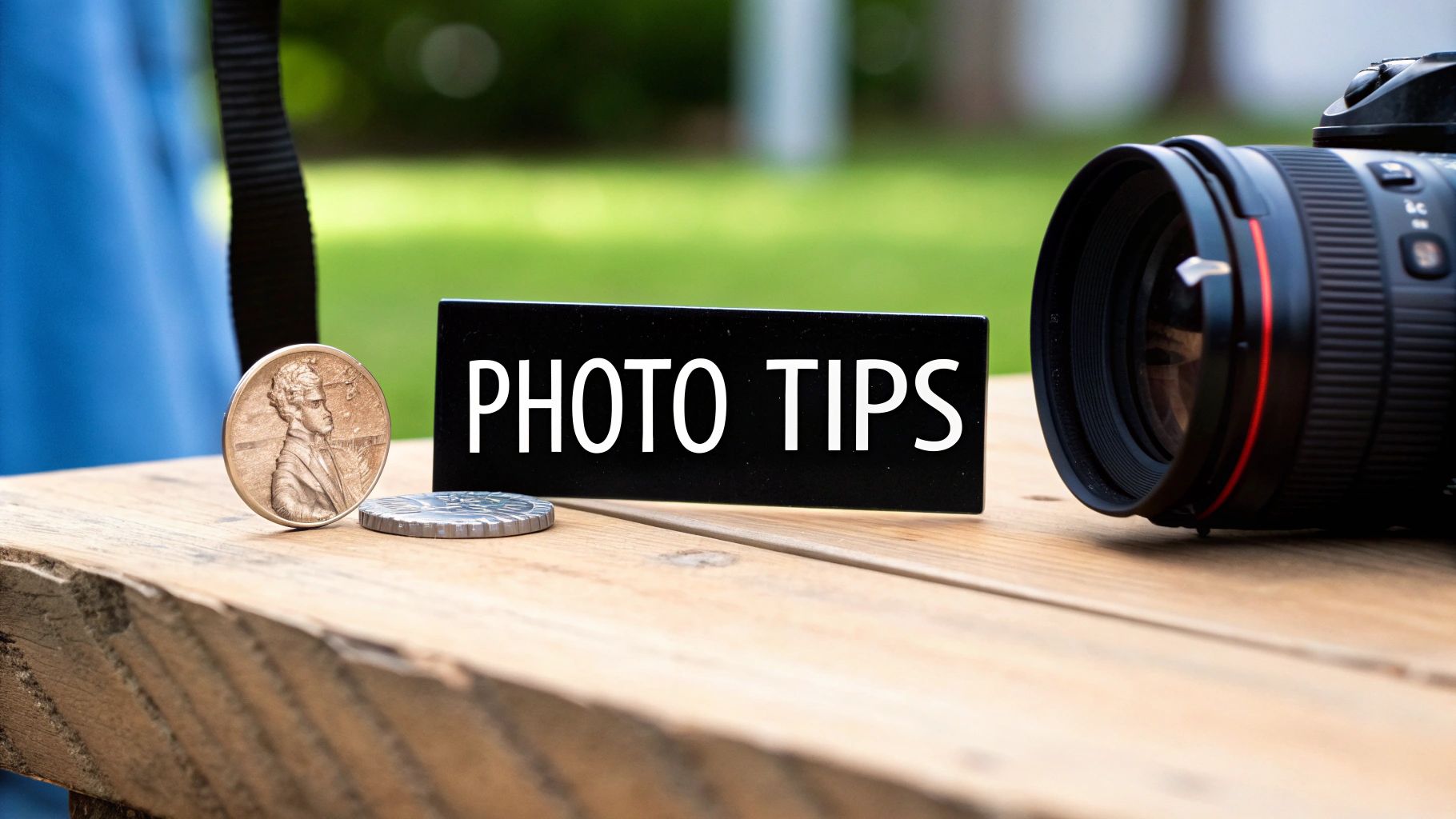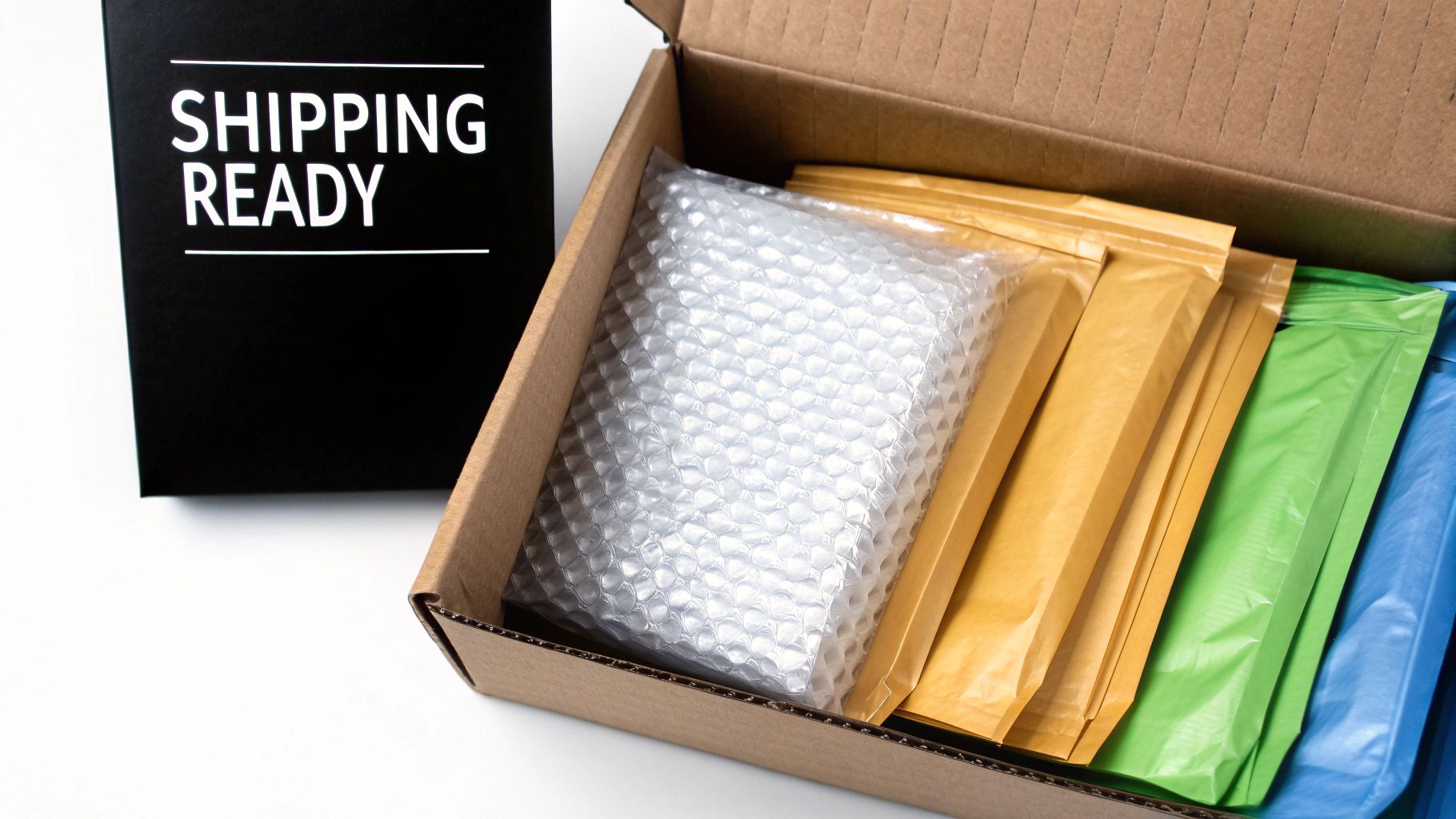So, you're thinking about selling some coins on eBay? It's a fantastic marketplace, especially for UK collectors, but turning those spare pennies or silver crowns into a tidy profit takes more than just snapping a quick picture. To really succeed, you need to approach it like a pro.
It all boils down to a clear process: identifying what you've got, showing it off with great photos, writing a description that gets you found, and then nailing the pricing and shipping. Get these steps right, and you'll build the kind of trust that turns one-off buyers into repeat customers.
Your Essential Guide to Selling Coins on eBay
Welcome to the world of selling coins on eBay. It's a bustling marketplace with enormous potential, but it's also a competitive one. The key is to present your coins professionally so they stand out from the crowd. Whether you're listing common British pennies or a rare sovereign, eBay gives you direct access to a massive audience of keen buyers, all from the comfort of your home.
This guide will walk you through the entire journey, from that first bit of research to the moment you post the sold coin. Let's break down the core stages you need to master:
- Know Your Coin: First things first, you need to know exactly what you have. What's its denomination, year, and monarch? And most importantly, what's its condition? This is the absolute foundation of a good listing.
- Picture Perfect: Clear, detailed photos are non-negotiable. You'll need sharp shots of the coin's obverse (the 'heads' side), reverse ('tails'), and the edge. This is what serious bidders will scrutinise before they even think about placing a bid.
- Create a Killer Listing: Your title and description are your sales pitch. They need to be both informative and packed with the right keywords so collectors can actually find your coin in a sea of others.
- Price It Right: This is where many sellers stumble. Deciding between a classic auction or a 'Buy It Now' price can make a huge difference to your final profit.
- Ship It Safe: Getting the coin to its new owner safely is the final, crucial step. Secure packaging protects your sale, your reputation, and earns you that all-important positive feedback.
Before we dive deeper, here's a quick summary of how these stages fit together.
The Coin Selling Process on eBay at a Glance
This table outlines the essential steps for successfully selling a coin on eBay. Following this path helps ensure you cover all your bases, from preparation right through to post-sale actions.
| Stage | Key Action | Why It Matters |
|---|---|---|
| Preparation | Accurately identify and grade your coin. | Forms the basis of an honest and trustworthy listing. |
| Photography | Take high-quality, detailed photos of all sides. | This is a buyer's primary way of judging the coin's condition. |
| Listing | Write a keyword-rich title and a clear description. | Helps your coin get discovered by the right buyers in searches. |
| Pricing | Research sold listings to set a competitive price. | A smart strategy maximises your potential profit. |
| Shipping | Choose a secure and appropriate postage method. | Ensures the coin arrives safely and protects your seller rating. |
| Post-Sale | Communicate with the buyer and ship promptly. | Builds a good reputation and encourages positive feedback. |
Each step logically flows into the next, building a strong foundation for a successful sale.
This simple infographic really drives home the thinking behind setting a good price.

As you can see, pricing isn't just a wild guess. It's a decision you make after doing your homework, properly identifying your coin, and then checking what similar items have actually sold for on the platform.
The UK coin scene on eBay is incredibly active. In fact, data shows that a whopping 29% of British eBay sellers are involved in this market. That puts you in a large, competitive community within eBay's colossal ecosystem of nearly 2 billion global listings. If you're curious about the numbers, you can explore more of eBay's market dynamics over on Analyzify's statistics page.
Preparing Your Coins for a Successful Sale

Before you even dream of writing an eBay listing, the real groundwork begins with the coins sitting in front of you. A great sale is built on a foundation of thorough prep and an honest assessment. Get this stage right, and you'll build the trust that encourages buyers to hit that ‘bid’ or ‘buy’ button.
Your very first job is to identify exactly what you've got. This means going beyond just its face value; you need to pin down its year, the monarch, and its specific variety. Resources like the Standard Catalog of World Coins are brilliant for this, as are online databases from places like the Numismatic Guaranty Corporation (NGC). These tools can be the difference between identifying a common piece and a genuinely scarce one.
Understanding and Grading Your Coins
Once you know what the coin is, you need to judge its condition. In the world of coins, we call this its grade, and it's one of the biggest factors that will determine its value when you sell on eBay. Here in the UK, you’ll see these terms pop up all the time:
- Fine (F): The coin shows quite a bit of wear, but you can still make out all the major details.
- Very Fine (VF): There's some minor wear, but only on the highest points of the design.
- Extremely Fine (EF): You'll see very light wear, with nearly all the fine details still looking sharp.
- Uncirculated (UNC): This is a coin in mint state. It looks like it just left the Royal Mint and has no signs of wear from being in circulation.
Being brutally honest about the grade is absolutely vital. A classic beginner's mistake is over-grading a coin. An experienced collector will spot that a mile off, and your credibility as a seller will take an instant hit. This leads us to the golden rule of coin preparation.
Whatever you do, never clean your coins. It's so tempting to want to polish up a dull silver shilling or scrub the grime off an old penny, but this is a catastrophic mistake. Cleaning creates thousands of tiny, unnatural scratches and strips away the original patina. This can completely destroy a coin’s numismatic value. Collectors want originality, not a shiny but damaged piece.
Raw vs Slabbed Coins: Which Is Right for Your Listing?
When you come to sell coins on eBay, they'll either be ‘raw’ (meaning loose) or ‘slabbed’ (professionally graded and sealed in a plastic holder by a third-party service). For a raw coin, the grade is down to your own assessment and how the buyer interprets your photographs.
For very rare or high-value coins, it can be a smart move to invest in professional grading from a trusted service like PCGS or NGC. A ‘slabbed’ coin offers buyers a guaranteed grade from impartial experts. This gives them huge confidence and almost always fetches a much higher price, easily covering the grading fee.
For most common-or-garden coins, though, it’s simply not necessary. A careful, honest self-assessment is more than enough to get the job done.
Creating eBay Listings That Attract Bidders

Think of your eBay listing as your personal shop window. With so many other coins vying for a collector's eye, a well-put-together listing isn't just a nice-to-have; it's absolutely essential. This is your chance to pair great photos with an honest, detailed story that turns a casual browser into a committed bidder.
It all begins with your photography. Collectors are a meticulous bunch, and your photos need to satisfy their sharp eyes. You don't need a fancy studio setup – a good smartphone and a bit of know-how will do the trick. Natural, diffused daylight is your best asset. You absolutely must avoid using a harsh flash, as it creates glare and washes out the very details a buyer wants to see.
Place your coin on a simple, neutral background. A piece of plain white card or dark felt works wonders, making the coin the star of the show. Make sure you capture every angle:
- The Obverse: Get a clear, sharp shot of the 'heads' side.
- The Reverse: Do the same for the 'tails' side, ensuring it’s just as detailed.
- The Edge: A focused picture of the coin's edge is crucial, as it can reveal reeding, security text, or other important features.
These images are your number one sales tool. If your photos are blurry or dark, it signals carelessness. Worse, it can make potential buyers think you’re trying to hide flaws. Take your time and get them right.
Writing Titles and Descriptions That Convert
Once you have your photos sorted, it's time to tackle the title. This is your most important bit of real estate on eBay. A vague title like "Old Silver Coin" is a recipe for getting lost in the crowd. Your title needs to be a compact, fact-filled summary.
A really effective title includes the coin's denomination, the monarch or figure, its year, metal, and grade. So, instead of a generic title, you should write something like: "George V Silver Shilling 1922 - Good Very Fine (GVF) Condition - British Coin." This tells a collector everything they need to know at a glance to decide whether to click.
The description is where you elaborate on the title and, most importantly, build trust. Honesty is everything here. Start by repeating the coin's key details and your assessed grade. Then, and this is critical, disclose every single flaw, no matter how small you think it is. Mention any scratches, knocks to the edge, or areas of uneven toning.
A transparent description is the bedrock of a good seller reputation. Experienced collectors will notice flaws in your photos anyway, so pointing them out yourself shows you're an honest and knowledgeable seller they can trust. This approach leads to better feedback and repeat customers.
Try to think of the description as telling the coin's story. If you know any interesting historical context, a brief mention can add a layer of appeal beyond just the raw data. Many experienced sellers create a simple template to ensure they cover all the bases for each listing, a practice we delve into further in our guide to selling coins effectively on eBay.
By combining crystal-clear photos with detailed, transparent descriptions, you create a listing that doesn't just get views—it converts them into confident bids.
Pricing Your Coins to Maximise Profit
Setting the right price when you sell coins on eBay is where your prep work really pays off. It’s a delicate balancing act. Go too high, and you’ll scare off potential bidders. Go too low, and you're leaving money on the table. The goal is to hit that sweet spot that encourages a quick sale while getting you the best possible return.
The first big decision you'll face is the listing format: Auction or Buy It Now. There's no single correct answer here; the best choice really depends on the specific coin you're selling.
-
Auction-Style Listings: This format is perfect for coins that are genuinely rare, in an exceptionally high grade, or feature a unique error. An auction can spark a "bidding war" between passionate collectors, often driving the final price well beyond what you might have listed it for. If you've got a sought-after piece and you're not entirely sure of its market value, an auction lets the buyers themselves decide what it's truly worth.
-
Buy It Now (Fixed Price): This is your best bet for more common coins where the market value is already well-established. Think of things like common-date Victorian pennies or modern circulating commemoratives. Collectors who know exactly what they want, and what they're willing to pay, often prefer the convenience of an instant purchase.
Researching for Realistic Benchmarks
Guesswork is the absolute enemy of profit. The most reliable way to figure out your coin's value is to see what similar items have actually sold for. Luckily, eBay has the perfect tool built right in.
Use the search bar to find coins just like yours, but here’s the crucial part: filter the results to show "Sold Items" or "Completed Items." This is how you see what buyers have genuinely paid, not just what other sellers are asking. Pay very close attention to the grade and quality of those sold coins. Even a small difference in condition can lead to a huge difference in the final price.
Remember, a coin's value isn't just one thing. It's a combination of rarity, precious metal content, historical significance, and current market trends. A Roman coin's value is deeply tied to its history, while a modern silver coin's value is often linked more closely to its metal content and collector demand.
Understanding Market Dynamics
The coin collecting world on eBay is surprisingly lively. Data has shown coin sell-through rates as high as 1,525%, with top sellers listing rare pieces for over $2,100, even when their face value was only $50. In the UK, this is especially true for limited-edition 50p coins and unique banknotes, which attract serious collector attention and can push prices far beyond their face value. You can find more insights on how to successfully sell coins on eBay from Zikanalytics.
This kind of market activity really highlights why getting the price right is so important. For a deeper dive into valuation, our guide on how to sell old coins offers extra strategies to help you make an informed decision. By combining solid research with the right listing format, you put your coins in the best possible position to attract serious buyers and achieve their maximum value.
Secure Shipping and Handling for Coins

Once the buyer pays, your job isn't quite done. A sale is only truly complete when that coin is safely in your customer’s hands. Nailing this final step is what protects your investment, heads off any potential disputes, and helps you earn that all-important positive feedback that will fuel your future sales.
Proper packaging is your first line of defence. Your coin should already be in a protective holder, ideally a non-PVC plastic flip. These inert flips are crucial as they prevent chemical reactions that can tarnish a coin's surface over time. From there, never just drop it into a standard letter envelope – it’s a sure-fire way to get it mangled by Royal Mail’s sorting machines.
Instead, the coin needs to go inside a rigid, padded mailer. For a bit of extra security, I always like to sandwich the coin flip between two small pieces of stiff cardboard before putting it in the mailer. This simple trick prevents the coin from bending or being crushed in transit, making sure it arrives in the exact condition you described.
Choosing the Right UK Postage
With the coin packed up securely, you need to pick the right shipping service. This decision really boils down to the final value of the coin. For most UK sellers, there are a couple of go-to options from Royal Mail:
- Royal Mail Signed For: This is a fantastic, cost-effective choice for lower-value coins. It gives you proof of delivery and gets a signature from the recipient, which is vital for qualifying for eBay's seller protection.
- Royal Mail Special Delivery Guaranteed: For any valuable coin, this is the only service you should be using. It provides full end-to-end tracking, a signature on delivery, and most importantly, it includes consequential loss insurance that covers the full value of numismatic items.
Trying to save a few quid by under-insuring a valuable coin is a risk that simply isn't worth taking. Always, always choose a service that covers the full sale price.
It’s absolutely essential to calculate your shipping costs before you list the item. Weigh your packaged coin and use Royal Mail's price finder to get the exact cost. By factoring this into your listing price or setting a fair postage fee, you avoid the nasty surprise of having your profit eaten up by shipping.
Final Steps for a Smooth Transaction
With the right postage sorted, a few final touches are what separate the amateurs from the pros. As soon as you have the tracking number, upload it to the eBay order page. This not only keeps your buyer in the loop but is also a key requirement for eBay's seller protection policy.
Finally, communication is everything. A quick, friendly message to your buyer makes all the difference. Something as simple as, "Hi, just to let you know your coin has been posted and the tracking details are now on eBay," builds trust and reassures them that their purchase is on its way. This small effort goes a long way towards securing a five-star experience and encouraging them to come back for more.
Frequently Asked Questions About Selling Coins on eBay
When you first start selling coins on eBay, it’s natural to have questions. Getting your head around the common sticking points will help you navigate the marketplace like a pro, sidestepping the usual pitfalls and selling with confidence.
One of the first things people want to know is which UK coins are actually worth selling. While the market can be unpredictable, a few categories consistently draw in buyers.
- Commemorative 50p Coins: Everyone's heard of the Kew Gardens 50p, and for good reason. Designs with low mintage figures like that one are always hot property among collectors.
- Limited Edition £2 Coins: It's a similar story for £2 coins. If you have a specific design celebrating a historical event or famous figure, you can bet collectors are looking for it.
- Pre-1947 Silver Coins: This is a big one. Before 1947, these coins were made with real silver, giving them an inherent metal value on top of their collectable appeal. Both investors and numismatists hunt for these.
The real trick is to look for coins with low production numbers or interesting minting errors—those are the details that get serious hobbyists excited. A great tip is to use eBay's 'Sold Items' filter for these categories. It gives you a real-time snapshot of what people are actually paying. If you want to dig deeper into what makes certain pieces valuable, our guide on a coin collection's value breaks it all down.
Choosing Your Sales Format
Another common puzzle is deciding between an auction and a 'Buy It Now' listing. There's no single right answer; it really depends on what you're selling.
If you've got a highly sought-after coin or a unique error piece, an auction is often your best bet. It can be tough to put a price on something truly rare. By starting with a sensible opening bid, you can build up excitement and let the market decide its true value. You might be pleasantly surprised by the final price.
On the other hand, for more common coins where the value is pretty well-established, a 'Buy It Now' listing just makes more sense. It’s a straightforward, no-fuss approach that gives buyers the convenience they want and often leads to a much quicker sale for you.
Stay professional and calm. The first step is to refer back to your original listing's high-quality photos and detailed, honest description.
Handling Disputes or Returns
Sooner or later, you might face a dispute or a return request. The key is not to panic.
If you were completely transparent about the coin's condition from the start, you can politely refer the buyer back to your photos and description. If they have a genuine issue, it’s often best to just accept the return to maintain your seller rating. eBay's seller protection policies are there to help, but only if you've done everything by the book—that means using tracked shipping and describing your items with 100% accuracy.
At Cavalier Coins Ltd, we are passionate about helping collectors at every stage of their journey. Whether you are buying your first coin or selling a prized collection, our extensive selection and expert support are here for you. Explore our offerings at https://www.cavaliercoins.com.

